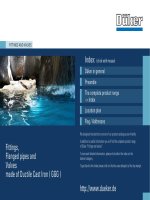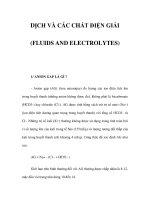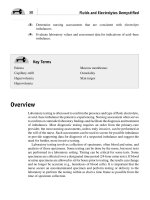2015 fluids and electrolytes made incredibly easy
Bạn đang xem bản rút gọn của tài liệu. Xem và tải ngay bản đầy đủ của tài liệu tại đây (7.67 MB, 590 trang )
made
Fluids &Electrolytes
Sixth Edition
0 .Wolters Kluwer
Phb6clph!a • 8albm0~ • New Yotk • london
Buenos A11H • Hong Kong • sydney • Tol
AcquisitionsEditor:ShannonW.Magee
ProductDevelopmentEditor:MariaM.McAvey
SeniorMarketingManager:MarkWiragh
EditorialAssistant:ZacharyShapiro
ProductionProjectManager:MarianBellus
DesignCoordinator:ElaineKasmer
ManufacturingCoordinator:KathleenBrown
PrepressVendor:AbsoluteService,Inc.
SixthEdition
Copyright©2015WoltersKluwerHealth
Copyright©2010LippincottWilliams&Wilkins
Allrightsreserved.Thisbookisprotectedbycopyright.Nopartofthisbookmaybereproducedortransmittedinanyformorbyanymeans,
includingasphotocopiesorscanned-inorotherelectroniccopies,orutilizedbyanyinformationstorageandretrievalsystemwithoutwritten
permissionfromthecopyrightowner,exceptforbriefquotationsembodiedincriticalarticlesandreviews.Materialsappearinginthisbook
preparedbyindividualsaspartoftheirofficialdutiesasU.S.governmentemployeesarenotcoveredbytheabove-mentionedcopyright.To
requestpermission,pleasecontactWoltersKluwerHealthatTwoCommerceSquare,2001MarketStreet,Philadelphia,PA19103,viaemailat
,orviaourwebsiteatlww.com(productsandservices).
PrintedinChina
LibraryofCongressCataloging-in-PublicationData
Fluids&electrolytesmadeincrediblyeasy!/clinicaleditor,LauraWillis.—Sixthedition.
p.;cm.
Fluidsandelectrolytesmadeincrediblyeasy!
Includesbibliographicalreferencesandindex.
ISBN978-1-4511-9396-1
I.Willis,Laura,1969-editor.II.LippincottWilliams&Wilkins,issuingbody.III.Title:Fluidsandelectrolytesmadeincrediblyeasy!
[DNLM:1.Water-ElectrolyteImbalance—Nurses’Instruction.2.Water-ElectrolyteBalance—Nurses’Instruction.WD220]
RC630
616.3’9920231—dc23
2014043245
Thisworkisprovided“asis,”andthepublisherdisclaimsanyandallwarranties,expressorimplied,includinganywarrantiesastoaccuracy,
comprehensiveness,orcurrencyofthecontentofthiswork.
Thisworkisnosubstituteforindividualpatientassessmentbasedonhealthcareprofessionals’examinationofeachpatientand
considerationof,amongotherthings,age,weight,gender,currentorpriormedicalconditions,medicationhistory,laboratorydata,andother
factorsuniquetothepatient.Thepublisherdoesnotprovidemedicaladviceorguidanceandthisworkismerelyareferencetool.Healthcare
professionals,andnotthepublisher,aresolelyresponsiblefortheuseofthisworkincludingallmedicaljudgmentsandforanyresulting
diagnosisandtreatments.
Givencontinuous,rapidadvancesinmedicalscienceandhealthinformation,independentprofessionalverificationofmedicaldiagnoses,
indications,appropriatepharmaceuticalselectionsanddosages,andtreatmentoptionsshouldbemadeandhealthcareprofessionalsshould
consultavarietyofsources.Whenprescribingmedication,healthcareprofessionalsareadvisedtoconsulttheproductinformationsheet(the
manufacturer’spackageinsert)accompanyingeachdrugtoverify,amongotherthings,conditionsofuse,warnings,andsideeffectsand
identifyanychangesindosagescheduleorcontradictions,particularlyifthemedicationtobeadministeredisnew,infrequentlyused,orhasa
narrowtherapeuticrange.Tothemaximumextentpermittedunderapplicablelaw,noresponsibilityisassumedbythepublisherforanyinjury
and/ordamagetopersonsorproperty,asamatterofproductsliability,negligencelaworotherwise,orfromanyreferencetoorusebyany
personofthiswork.
LWW.com
987654321
Contents
PartI
Contributors
Priorcontributors
Foreword
Balancingbasics
1
Balancingfluids
2
Balancingelectrolytes
3
Balancingacidsandbases
PartII
Fluidandelectrolyteimbalances
4
Whenfluidstipthebalance
5
Whensodiumtipsthebalance
6
Whenpotassiumtipsthebalance
7
Whenmagnesiumtipsthebalance
8
Whencalciumtipsthebalance
9
Whenphosphorustipsthebalance
10
Whenchloridetipsthebalance
11
Whenacidsandbasestipthebalance
PartIII
Disordersthatcauseimbalances
12
Heat-relatedhealthalterations
13
Heartfailure
14
Respiratoryfailure
15
ExcessiveGIfluidloss
16
Acutepancreatitis
17
Renalfailure
18
Burns
PartIV
Treatingimbalances
19
I.V.fluidreplacement
20
Totalparenteralnutrition
Appendicesandindex
Commonfluidandelectrolyteimbalancesinpediatricpatients
Commonfluidandelectrolyteimbalancesinelderlypatients
Transfusingbloodandselectedcomponents
Practicemakesperfect
Glossary
SelectedReferences
Index
Contributors
CherylBrady,MSN,RN,CNE
NursingFaculty
KentStateUniversity
Salem,OH
ShelbaDurston,MSN,RN,CCRN
NursingInstructor
SanJoaquinDeltaCollege
Stockton,CA
LauraFavand,MS,RN,CEN
ChiefofPlans,TrainingMobilization
U.S.ArmyMedicalDepartmentActivities
FortKnox,KY
MargaretGingrich,MSN,RN,CRNP
ProfessorofNursing
HarrisburgAreaCommunityCollege
Harrisburg,PA
MaryJones,DNP,CNM,ENP-BC,FNP-BC
FamilyNursePractitioner
DoctorofNursingPractice
MedQuestHealthCenter,Inc.
Mansfield,OH
RexannPickering,PhD,MS,RN,CIM,CIP
DirectorofContinuingMedicalandNursingEducation
MethodistLeBonheurHealthcare
Memphis,TN
CherieRebar,PhD,MBA,RN,FNP,COI
Director,DivisionofNursing
KetteringCollege
Dayton,OH
DonnaScemons,PhD,FNP-BC,CNS
AssistantProfessor
CaliforniaStateUniversity
LosAngeles,CA
AllisonTerry,PhD,MSN,RN
AssistantDeanofClinicalPractice
AuburnUniversity
Montgomery,AL
LeighAnnTrujillo,MSN,RN
PatientCareManager
UniversityofChicago
Chicago,IL
PriorContributors
CherylL.Brady,MSN,RN
ShelbaDurston,MSN,RN,CCRN
LauraR.Favand,MS,RN,CEN
MargaretM.Gingrich,MSN,RN
KarlaJones,MS,RN
PatriciaLemelle-Wright,MS,RN
LindaLudwig,BS,RN,MED
RexannG.Pickering,PhD,MS,RN,CIP,CIM
AlexisPuglia,RN
RoseanneHanlonRafter,MSN,RN,GCNS-BC
DonnaScemons,PhD,RN,FNP-C,CNS
VanessaM.Scheidt,RN,TNS,PHRN,FF2
AllisonJ.Terry,PhD,MSN,RN
LeighAnnTrujillo,BSN,RN
Foreword
Ifyouarelikeme,youaretoobusytowadethroughaforewordthatusespretentioustermsand
umpsteendullparagraphstogettothepoint.Solet’scutrighttothechase!Hereiswhythisbookis
soterrific:
1.Itwillteachyoualltheimportantthingsyouneedtoknowaboutfluidsandelectrolytes.(Itwill
leaveoutallthefluffthatwastesyourtime.)
2.Itwillhelpyourememberwhatyouhavelearned.
3.Itwillmakeyousmileasitenhancesyourknowledgeandskills.Don’tbelieveme?Trythese
recurringlogosonforsize:
Memoryjogger!—helpsyourememberandunderstanddifficultconcepts
CAUTION!—listsdangeroussignsandsymptomsandenablesyoutoquicklyrecognize
trouble
It’snotworking—helpsyoufindalternativeinterventionswhenpatientoutcomesaren’twhat
youexpected
Chartsmart—listscriticaldocumentationelementsthatcankeepyououtoflegaltrouble
Teachingpoints—providesclearpatient-teachingtipsthatyoucanusetohelpyourpatients
preventrecurrenceoftheproblem
Agesandstages—identifiesissuestowatchforinyourpediatricandgeriatricpatients
That’sawrap!—summarizeswhatyou’velearnedinthechapter
See?Itoldyou!Andthat’snotall.Lookformeandmyfriendsinthemarginsthroughoutthisbook.
Wewillbetheretoexplainkeyconcepts,provideimportantcarereminders,andofferreassurance.
Oh,andifyoudon’tmind,we’llbespicingupthepageswithabitofhumoralongthewaytoteach
andentertaininawaythatnootherresourcecan.
Ihopeyoufindthisbookhelpful.Bestofluckthroughoutyourcareer!
PartI
Balancingbasics
1
Balancing
fluids
2
Balancing
electrolytes
3
Balancing
acidsand
bases
Chapter1
Balancingfluids
Justthefacts
Inthischapter,you’lllearn:
♦
theprocessoffluiddistributionthroughoutthebody
♦
themeaningsofcertainfluid-relatedterms
♦
thedifferentwaysfluidmovesthroughthebody
♦
therolesthathormonesandkidneysplayinfluidbalance.
Alookatfluids
Wherewouldwebewithoutbodyfluids?Fluidsarevitaltoallformsoflife.Theyhelpmaintain
bodytemperatureandcellshape,andtheyhelptransportnutrients,gases,andwastes.Let’stakea
closelookatfluidsandthewaythebodybalancesthem.
Makinggainsequallosses
Justaboutallmajororgansworktogethertomaintaintheproperbalanceoffluid.Tomaintainthat
balance,theamountoffluidgainedthroughoutthedaymustequaltheamountlost.Someofthose
lossescanbemeasured;otherscan’t.
Howinsensible
Fluidlossesfromtheskinandlungsarereferredtoasinsensiblelossesbecausetheycan’tbe
measuredorseen.Lossesfromevaporationoffluidthroughtheskinarefairlyconstantbutdepend
onaperson’stotalbodysurfacearea.Forexample,thebodysurfaceareaofaninfantisgreater
thanthatofanadultrelativetotheirrespectiveweights.Becauseofthisdifferenceinbodysurface
area—ahighermetabolicrate,alargerpercentageofextracellularbodyfluid,andimmature
kidneyfunction—infantstypicallylosemorewaterthanadultsdo.
Changesinenvironmentalhumiditylevelsalsoaffecttheamountoffluidlostthroughtheskin.
Likewise,respiratoryrateanddepthaffecttheamountoffluidlostthroughthelungs.Tachypnea,
forexample,causesmorewatertobelost;bradypnea,less.Feverincreasesinsensiblelossesof
fluidfromboththeskinandlungs.
Nowthat’ssensible
Fluidlossesfromurination,defecation,wounds,andothermeansarereferredtoassensible
lossesbecausetheycanbemeasured.
Atypicaladultlosesabout150to200ml/dayoffluidthroughdefecation.Incasesofsevere
diarrhea,lossesmayexceed5,000ml/day(Wait&Alouidor,2011).(Formoreinformationabout
insensibleandsensiblelosses,seeSitesinvolvedinfluidloss.)
Sitesinvolvedinfluidloss
Eachday,thebodygainsandlosesfluidthroughseveraldifferentprocesses.Thisillustrationshows
theprimarysitesoffluidlossesandgainsaswellastheiraverageamounts.Gastric,intestinal,
pancreatic,andbiliarysecretionsarealmostcompletelyreabsorbedandaren’tusuallycountedin
dailyfluidlossesandgains.
Followingthefluid
Thebodyholdsfluidintwobasicareas,orcompartments—insidethecellsandoutsidethecells.
Fluidfoundinsidethecellsiscalledintracellularfluid(ICF);fluidfoundoutsidethecells,
extracellularfluid(ECF).Capillarywallsandcellmembranesseparatetheintracellularand
extracellularcompartments.(SeeFluidcompartments.)
Fluidcompartments
Thisillustrationshowstheprimaryfluidcompartmentsinthebody:intracellularandextracellular.
Extracellularisfurtherdividedintointerstitialandintravascular.Capillarywallsandcellmembranes
separateICFsfromECFs.
Memoryjogger
Tohelpyourememberwhichfluidbelongsinwhichcompartment,keepinmindthatintermeans
between(asininterval—betweentwoevents)andintrameanswithinorinside(asinintravenous
—insideavein).
Tomaintainproperfluidbalance,thedistributionoffluidbetweenthetwocompartmentsmust
remainrelativelyconstant.Inanaverageadult,thetotalamountoffluidis42L,withthetotal
amountofICFaveraging40%oftheperson’sbodyweight,orabout28L(Seager&Slaubaugh,
2011).ThetotalamountofECFaverages20%oftheperson’sbodyweight,orabout14L.
ECFcanbebrokendownfurtherintointerstitialfluid,whichsurroundsthecells,and
intravascularfluidorplasma,whichistheliquidportionofblood.Inanadult,interstitialfluid
accountsforabout75%oftheECF.Plasmaaccountsfortheremaining25%.
Thebodycontainsotherfluids,calledtranscellularfluids,inthecerebrospinalcolumn,pleural
cavity,lymphsystem,joints,andeyes.Transcellularfluidsgenerallyaren’tsubjecttosignificant
gainsandlossesthroughoutthedaysotheyaren’tdiscussedindetailhere.
Waterhere,waterthere
Thedistributionoffluidwithinthebody’scompartmentsvarieswithage.Comparedwithadults,
infantshaveagreaterpercentageofbodywaterstoredinsideinterstitialspaces.About75%to
80%(40%ECF,35%ICF)ofthebodyweightofafull-termneonateiswater.About90%(60%
ECFand30%ICF)ofthebodyweightofapremature(23weeksgestation)infantiswater
(Ambalavanan&Rosenkrantz,2012).Theamountofwaterasapercentageofbodyweight
decreaseswithageuntilpuberty.Inatypical154-lb(70kg)leanadultmale,about60%(93lb[42
kg])ofbodyweightiswater.(SeeTheevaporationoftime.)
Agesandstages
Theevaporationoftime
Theriskofsufferingafluidimbalanceincreaseswithage.Why?Skeletalmusclemassdeclines,and
theproportionoffatwithinthebodyincreases.Afterage60years,watercontentdropstoabout45%.
Likewise,thedistributionoffluidwithinthebodychangeswithage.Forinstance,about15%ofa
typicalyoungadult’stotalbodyweightismadeupofinterstitialfluid.Thatpercentageprogressively
decreaseswithage.
About5%ofthebody’stotalfluidvolumeismadeupofplasma.Plasmavolumeremainsstable
throughoutlife.
Skeletalmusclecellsholdmuchofthatwater;fatcellscontainlittleofit.Women,who
normallyhaveahigherratiooffattoskeletalmusclethanmen,typicallyhaveasomewhatlower
relativewatercontent.Likewise,anobesepersonmayhavearelativewatercontentlevelaslow
as45%.Accumulatedbodyfatintheseindividualsincreasesweightwithoutboostingthebody’s
watercontent.
Fluidtypes
Fluidsinthebodygenerallyaren’tfoundinpureforms.They’reusuallyfoundinthreetypesof
solutions:isotonic,hypotonic,andhypertonic.
Isotonic:Alreadyatmatchpoint
Anisotonicsolutionhasthesamesolute(matterdissolvedinsolution)concentrationasanother
solution.Forinstance,iftwofluidsinadjacentcompartmentsareequallyconcentrated,they’re
alreadyinbalance,sothefluidinsideeachcompartmentstaysput.Noimbalancemeansnonet
fluidshift.(SeeUnderstandingisotonicfluids.)
Understandingisotonicfluids
Nonetfluidshiftsoccurbetweenisotonicsolutionsbecausethesolutionsareequallyconcentrated.
Forexample,normalsalinesolutionisconsideredisotonicbecausetheconcentrationofsodium
inthesolutionnearlyequalstheconcentrationofsodiumintheblood.
Hypotonic:Getthelowdown
Ahypotonicsolutionhasalowersoluteconcentrationthananothersolution.Forinstance,sayone
solutioncontainsonlyonepartsodiumandanothersolutioncontainstwoparts.Thefirstsolution
ishypotoniccomparedwiththesecondsolution.Asaresult,fluidfromthehypotonicsolution
wouldshiftintothesecondsolutionuntilthetwosolutionshadequalconcentrationsofsodium.
Rememberthatthebodyconstantlystrivestomaintainastateofbalance,orequilibrium(also
knownashomeostasis).(SeeUnderstandinghypotonicfluids.)
Understandinghypotonicfluids
Whenalessconcentrated,orhypotonic,solutionisplacednexttoamoreconcentratedsolution,fluid
shiftsfromthehypotonicsolutionintothemoreconcentratedcompartmenttoequalizeconcentrations.
Half-normalsalinesolutionisconsideredhypotonicbecausetheconcentrationofsodiuminthe
solutionislessthantheconcentrationofsodiuminthepatient’sblood.
Hypertonic:Justthehighlights
Ahypertonicsolutionhasahighersoluteconcentrationthananothersolution.Forinstance,sayone
solutioncontainsalargeamountofsodiumandasecondsolutioncontainshardlyany.Thefirst
solutionishypertoniccomparedwiththesecondsolution.Asaresult,fluidfromthesecond
solutionwouldshiftintothehypertonicsolutionuntilthetwosolutionshadequalconcentrations.
Again,thebodyconstantlystrivestomaintainastateofequilibrium(homeostasis).(See
Understandinghypertonicfluids.)
Understandinghypertonicfluids
Ifonesolutionhasmoresolutesthananadjacentsolution,ithaslessfluidrelativetotheadjacent
solution.Fluidwillmoveoutofthelessconcentratedsolutionintothemoreconcentrated,or
hypertonic,solutionuntilbothsolutionshavethesameamountofsolutesandfluid.
Forexample,asolutionofdextrose5%innormalsalinesolutionisconsideredhypertonic
becausetheconcentrationofsolutesinthesolutionisgreaterthantheconcentrationofsolutesin
thepatient’sblood.
Fluidmovement
Justastheheartconstantlybeats,fluidsandsolutesconstantlymovewithinthebody.That
movementallowsthebodytomaintainhomeostasis,theconstantstateofbalancethebodyseeks.
(SeeFluidtips.)
Fluidtips
Fluids,nutrients,andwasteproductsconstantlyshiftwithinthebody’scompartments—fromthecells
totheinterstitialspaces,tothebloodvessels,andbackagain.Achangeinonecompartmentcanaffect
alloftheothers.
Keepingtrackoftheshifts
Thatcontinuousshiftingoffluidscanhaveimportantimplicationsforpatientcare.Forinstance,ifa
hypotonicfluid,suchashalf-normalsalinesolution,isgiventoapatient,itmaycausetoomuchfluid
tomovefromtheveinsintothecells,andthecellscanswell.Ontheotherhand,ifahypertonic
solution,suchasdextrose5%innormalsalinesolution,isgiventoapatient,itmaycausetoomuch
fluidtobepulledfromcellsintothebloodstream,andthecellsshrink.
FormoreinformationaboutI.V.solutions,seechapter19,I.V.fluidreplacement.
Withinthecells
Soluteswithintheintracellular,interstitial,andintravascularcompartmentsofthebodymove
throughthemembranes,separatingthosecompartmentsindifferentways.Themembranesare
semipermeable,meaningthattheyallowsomesolutestopassthroughbutnotothers.Inthis
section,you’lllearnthedifferentwaysfluidsandsolutesmovethroughmembranesatthecellular
level.
Goingwiththeflow
Indiffusion,solutesmovefromanareaofhigherconcentrationtoanareaoflowerconcentration,
whicheventuallyresultsinanequaldistributionofsoluteswithinthetwoareas.Diffusionisa
formofpassivetransportbecausenoenergyisrequiredtomakeithappen;itjusthappens.Like
fishswimmingwiththecurrent,thesolutessimplygowiththeflow.(SeeUnderstanding
diffusion.)
Understandingdiffusion
Indiffusion,solutesmovefromareasofhigherconcentrationtoareasoflowerconcentrationuntilthe
concentrationisequalinbothareas.
Givingthatextrapush
Inactivetransport,solutesmovefromanareaoflowerconcentrationtoanareaofhigher
concentration.Likeswimmingagainstthecurrent,activetransportrequiresenergytomakeit
happen.
Theenergyrequiredforasolutetomoveagainstaconcentrationgradientcomesfroma
substancecalledadenosinetriphosphateorATP.Storedinallcells,ATPsuppliesenergyfor
solutemovementinandoutofcells.(SeeUnderstandingactivetransport.)
Understandingactivetransport
Duringactivetransport,energyfromamoleculecalledadenosinetriphosphate(ATP)movessolutes
fromanareaoflowerconcentrationtoanareaofhigherconcentration.
Somesolutes,suchassodiumandpotassium,useATPtomoveinandoutofcellsinaformof
activetransportcalledthesodium-potassiumpump.(Formoreinformationonthisphysiologic
pump,seechapter5,Whensodiumtipsthebalance.)Othersolutesthatrequireactivetransportto
crosscellmembranesincludecalciumions,hydrogenions,aminoacids,andcertainsugars.
Lettingfluidsthrough
Osmosisreferstothepassivemovementoffluidacrossamembranefromanareaoflowersolute
concentrationandcomparativelymorefluidintoanareaofhighersoluteconcentrationand
comparativelylessfluid.Osmosisstopswhenenoughfluidhasmovedthroughthemembraneto
equalizethesoluteconcentrationonbothsidesofthemembrane.(SeeUnderstandingosmosis.)
Understandingosmosis
Inosmosis,fluidmovespassivelyfromareaswithmorefluid(andfewersolutes)toareaswithless
fluid(andmoresolutes).Rememberthatinosmosis,fluidmoves,whereasindiffusion,solutesmove.
Withinthevascularsystem
Withinthevascularsystem,onlycapillarieshavewallsthinenoughtoletsolutespassthrough.
Themovementoffluidsandsolutesthroughcapillarywallsplaysacriticalroleinthebody’sfluid
balance.
Thepressureison
Themovementoffluidsthroughcapillaries—aprocesscalledcapillaryfiltration—resultsfrom
bloodpushingagainstthewallsofthecapillary.Thatpressure,calledhydrostaticpressure,forces
fluidsandsolutesthroughthecapillarywall.
Whenthehydrostaticpressureinsideacapillaryisgreaterthanthepressureinthesurrounding
interstitialspace,fluidsandsolutesinsidethecapillaryareforcedoutintotheinterstitialspace.
Whenthepressureinsidethecapillaryislessthanthepressureoutsideofit,fluidsandsolutes
movebackintothecapillary.(SeeFluidmovementthroughcapillaries.)
Fluidmovementthroughcapillaries
Whenhydrostaticpressurebuildsinsideacapillary,itforcesfluidsandsolutesoutthroughthe
capillarywallsintotheinterstitialfluid,asshownbelow.
Keepingthefluidin
Aprocesscalledreabsorptionpreventstoomuchfluidfromleavingthecapillariesnomatterhow
muchhydrostaticpressureexistswithinthecapillaries.Whenfluidfiltersthroughacapillary,the
proteinalbuminremainsbehindinthediminishingvolumeofwater.Albuminisalargemolecule
thatnormallycan’tpassthroughcapillarymembranes.Astheconcentrationofalbumininsidea
capillaryincreases,fluidbeginstomovebackintothecapillariesthroughosmosis.
Thinkofalbuminasawatermagnet.Theosmotic,orpulling,forceofalbumininthe
intravascularspaceiscalledtheplasmacolloidosmoticpressure.Theplasmacolloidosmotic
pressureincapillariesaveragesabout25mmHg.(SeeAlbuminmagnetism.)
Albuminmagnetism
Albumin,alargeproteinmolecule,actslikeamagnettoattractwaterandholditinsidetheblood
vessel.
Aslongascapillarybloodpressure(thehydrostaticpressure)exceedsplasmacolloidosmotic
pressure,waterandsolutescanleavethecapillariesandentertheinterstitialfluid.When
capillarybloodpressurefallsbelowplasmacolloidosmoticpressure,wateranddiffusible
solutesreturntothecapillaries.
Normally,bloodpressureinacapillaryexceedsplasmacolloidosmoticpressureinthe
arterioleendandfallsbelowitinthevenuleend.Asaresult,capillaryfiltrationoccursalongthe
firsthalfofthevessel;reabsorption,alongthesecond.Aslongascapillarybloodpressureand
plasmaalbuminlevelsremainnormal,theamountofwaterthatmovesintothevesselequalsthe
amountthatmovesout.
Comingaroundagain
Occasionally,extrafluidfiltersoutofthecapillary.Whenthathappens,theexcessfluidshiftsinto
thelymphaticvesselslocatedjustoutsidethecapillariesandeventuallyreturnstotheheartfor
recirculation.
Maintainingthebalance
Manymechanismsinthebodyworktogethertomaintainfluidbalance.Becauseoneproblemcan
affecttheentirefluid-maintenancesystem,it’simportanttokeepallmechanismsincheck.Here’sa
closerlookatwhatmakesthisbalancingactpossible.









